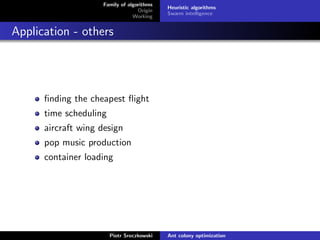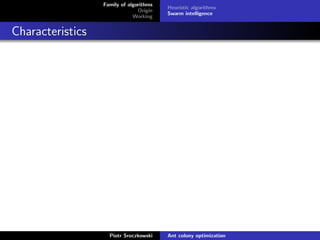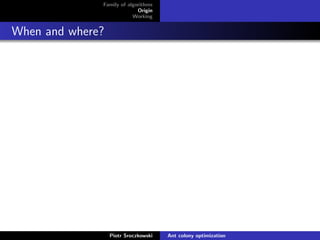Ad
Ant Colony Optimization (Heuristic algorithms & Swarm intelligence)
- 1. Family of algorithms Origin Working Ant colony optimization Piotr Sroczkowski Brainhub April 20, 2017 Piotr Sroczkowski Ant colony optimization
- 2. Family of algorithms Origin Working Summary I 1 Family of algorithms Heuristic algorithms Swarm intelligence 2 Origin 3 Working Piotr Sroczkowski Ant colony optimization
- 3. Family of algorithms Origin Working Heuristic algorithms Swarm intelligence What is Ant colony optimization? Piotr Sroczkowski Ant colony optimization
- 4. Family of algorithms Origin Working Heuristic algorithms Swarm intelligence What is Ant colony optimization? A family of algorithms Piotr Sroczkowski Ant colony optimization
- 5. Family of algorithms Origin Working Heuristic algorithms Swarm intelligence What and why? Piotr Sroczkowski Ant colony optimization
- 6. Family of algorithms Origin Working Heuristic algorithms Swarm intelligence What and why? Greek heurisco Piotr Sroczkowski Ant colony optimization
- 7. Family of algorithms Origin Working Heuristic algorithms Swarm intelligence What and why? Greek heurisco we look for not the best solution but a satisfiable one Piotr Sroczkowski Ant colony optimization
- 8. Family of algorithms Origin Working Heuristic algorithms Swarm intelligence What and why? Greek heurisco we look for not the best solution but a satisfiable one like in real life ex. finding the best product to buy Piotr Sroczkowski Ant colony optimization
- 9. Family of algorithms Origin Working Heuristic algorithms Swarm intelligence What and why? Greek heurisco we look for not the best solution but a satisfiable one like in real life ex. finding the best product to buy very often it’s impossible to create an algorithm which will find the optimum solution Piotr Sroczkowski Ant colony optimization
- 10. Family of algorithms Origin Working Heuristic algorithms Swarm intelligence What and why? Greek heurisco we look for not the best solution but a satisfiable one like in real life ex. finding the best product to buy very often it’s impossible to create an algorithm which will find the optimum solution ... or such a program (implementation of the algorithm) will run very long Piotr Sroczkowski Ant colony optimization
- 11. Family of algorithms Origin Working Heuristic algorithms Swarm intelligence What and why? Greek heurisco we look for not the best solution but a satisfiable one like in real life ex. finding the best product to buy very often it’s impossible to create an algorithm which will find the optimum solution ... or such a program (implementation of the algorithm) will run very long ... or a program which generates the program above will run very long Piotr Sroczkowski Ant colony optimization
- 12. Family of algorithms Origin Working Heuristic algorithms Swarm intelligence What and why? Greek heurisco we look for not the best solution but a satisfiable one like in real life ex. finding the best product to buy very often it’s impossible to create an algorithm which will find the optimum solution ... or such a program (implementation of the algorithm) will run very long ... or a program which generates the program above will run very long ... or running such a program will be very expensive (ex. in a cloud like AWS, Digital Ocean, Microsoft Azure...) Piotr Sroczkowski Ant colony optimization
- 13. Family of algorithms Origin Working Heuristic algorithms Swarm intelligence What and why? Greek heurisco we look for not the best solution but a satisfiable one like in real life ex. finding the best product to buy very often it’s impossible to create an algorithm which will find the optimum solution ... or such a program (implementation of the algorithm) will run very long ... or a program which generates the program above will run very long ... or running such a program will be very expensive (ex. in a cloud like AWS, Digital Ocean, Microsoft Azure...) ... or a user will become frustrated because even 5 seconds to run a program could be a bad UX Piotr Sroczkowski Ant colony optimization
- 14. Family of algorithms Origin Working Heuristic algorithms Swarm intelligence What and why? Greek heurisco we look for not the best solution but a satisfiable one like in real life ex. finding the best product to buy very often it’s impossible to create an algorithm which will find the optimum solution ... or such a program (implementation of the algorithm) will run very long ... or a program which generates the program above will run very long ... or running such a program will be very expensive (ex. in a cloud like AWS, Digital Ocean, Microsoft Azure...) ... or a user will become frustrated because even 5 seconds to run a program could be a bad UX ... Piotr Sroczkowski Ant colony optimization
- 15. Family of algorithms Origin Working Heuristic algorithms Swarm intelligence Application - medicine / bioinformatics Piotr Sroczkowski Ant colony optimization
- 16. Family of algorithms Origin Working Heuristic algorithms Swarm intelligence Application - medicine / bioinformatics clinical decision support system Piotr Sroczkowski Ant colony optimization
- 17. Family of algorithms Origin Working Heuristic algorithms Swarm intelligence Application - medicine / bioinformatics clinical decision support system MSA (multiple sequence alignment) - genetics Piotr Sroczkowski Ant colony optimization
- 18. Family of algorithms Origin Working Heuristic algorithms Swarm intelligence Application - software engineering Piotr Sroczkowski Ant colony optimization
- 19. Family of algorithms Origin Working Heuristic algorithms Swarm intelligence Application - software engineering mutation testing Piotr Sroczkowski Ant colony optimization
- 20. Family of algorithms Origin Working Heuristic algorithms Swarm intelligence Application - software engineering mutation testing virus detection Piotr Sroczkowski Ant colony optimization
- 21. Family of algorithms Origin Working Heuristic algorithms Swarm intelligence Application - software engineering mutation testing virus detection file allocation for a distributed system Piotr Sroczkowski Ant colony optimization
- 22. Family of algorithms Origin Working Heuristic algorithms Swarm intelligence Application - software engineering mutation testing virus detection file allocation for a distributed system parallelization Piotr Sroczkowski Ant colony optimization
- 23. Family of algorithms Origin Working Heuristic algorithms Swarm intelligence Application - software engineering mutation testing virus detection file allocation for a distributed system parallelization planning database queries Piotr Sroczkowski Ant colony optimization
- 24. Family of algorithms Origin Working Heuristic algorithms Swarm intelligence Application - software engineering mutation testing virus detection file allocation for a distributed system parallelization planning database queries queueing Piotr Sroczkowski Ant colony optimization
- 25. Family of algorithms Origin Working Heuristic algorithms Swarm intelligence Application - software engineering mutation testing virus detection file allocation for a distributed system parallelization planning database queries queueing virtual DOM in React Piotr Sroczkowski Ant colony optimization
- 26. Family of algorithms Origin Working Heuristic algorithms Swarm intelligence Application - police / security Piotr Sroczkowski Ant colony optimization
- 27. Family of algorithms Origin Working Heuristic algorithms Swarm intelligence Application - police / security construction of facial composites from eyewitnesses Piotr Sroczkowski Ant colony optimization
- 28. Family of algorithms Origin Working Heuristic algorithms Swarm intelligence Application - police / security construction of facial composites from eyewitnesses design of anti-terrorism systems Piotr Sroczkowski Ant colony optimization
- 29. Family of algorithms Origin Working Heuristic algorithms Swarm intelligence Application - others Piotr Sroczkowski Ant colony optimization
- 30. Family of algorithms Origin Working Heuristic algorithms Swarm intelligence Application - others finding the cheapest flight Piotr Sroczkowski Ant colony optimization
- 31. Family of algorithms Origin Working Heuristic algorithms Swarm intelligence Application - others finding the cheapest flight time scheduling Piotr Sroczkowski Ant colony optimization
- 32. Family of algorithms Origin Working Heuristic algorithms Swarm intelligence Application - others finding the cheapest flight time scheduling aircraft wing design Piotr Sroczkowski Ant colony optimization
- 33. Family of algorithms Origin Working Heuristic algorithms Swarm intelligence Application - others finding the cheapest flight time scheduling aircraft wing design pop music production Piotr Sroczkowski Ant colony optimization
- 34. Family of algorithms Origin Working Heuristic algorithms Swarm intelligence Application - others finding the cheapest flight time scheduling aircraft wing design pop music production container loading Piotr Sroczkowski Ant colony optimization
- 35. Family of algorithms Origin Working Heuristic algorithms Swarm intelligence Application - next others Piotr Sroczkowski Ant colony optimization
- 36. Family of algorithms Origin Working Heuristic algorithms Swarm intelligence Application - next others there are so many applications so this presentation cannot contain them all Piotr Sroczkowski Ant colony optimization
- 37. Family of algorithms Origin Working Heuristic algorithms Swarm intelligence Characteristics Piotr Sroczkowski Ant colony optimization
- 38. Family of algorithms Origin Working Heuristic algorithms Swarm intelligence Characteristics small agents / boids Piotr Sroczkowski Ant colony optimization
- 39. Family of algorithms Origin Working Heuristic algorithms Swarm intelligence Characteristics small agents / boids they interact locally with one another Piotr Sroczkowski Ant colony optimization
- 40. Family of algorithms Origin Working Heuristic algorithms Swarm intelligence Characteristics small agents / boids they interact locally with one another they interact locally with the environment Piotr Sroczkowski Ant colony optimization
- 41. Family of algorithms Origin Working Heuristic algorithms Swarm intelligence Characteristics small agents / boids they interact locally with one another they interact locally with the environment the inspiration comes above all from the nature Piotr Sroczkowski Ant colony optimization
- 42. Family of algorithms Origin Working Heuristic algorithms Swarm intelligence Characteristics small agents / boids they interact locally with one another they interact locally with the environment the inspiration comes above all from the nature therefore (like in other heuristics) there is much randomness Piotr Sroczkowski Ant colony optimization
- 43. Family of algorithms Origin Working Heuristic algorithms Swarm intelligence Examples Piotr Sroczkowski Ant colony optimization
- 44. Family of algorithms Origin Working Heuristic algorithms Swarm intelligence Examples ant colony optimization Piotr Sroczkowski Ant colony optimization
- 45. Family of algorithms Origin Working Heuristic algorithms Swarm intelligence Examples ant colony optimization bee colony optimization Piotr Sroczkowski Ant colony optimization
- 46. Family of algorithms Origin Working Heuristic algorithms Swarm intelligence Examples ant colony optimization bee colony optimization firefly algorithm Piotr Sroczkowski Ant colony optimization
- 47. Family of algorithms Origin Working Heuristic algorithms Swarm intelligence Examples ant colony optimization bee colony optimization firefly algorithm bat algorithm Piotr Sroczkowski Ant colony optimization
- 48. Family of algorithms Origin Working Heuristic algorithms Swarm intelligence Examples ant colony optimization bee colony optimization firefly algorithm bat algorithm self-propelled particles Piotr Sroczkowski Ant colony optimization
- 49. Family of algorithms Origin Working Heuristic algorithms Swarm intelligence Examples ant colony optimization bee colony optimization firefly algorithm bat algorithm self-propelled particles charged system exploration Piotr Sroczkowski Ant colony optimization
- 50. Family of algorithms Origin Working Heuristic algorithms Swarm intelligence Examples ant colony optimization bee colony optimization firefly algorithm bat algorithm self-propelled particles charged system exploration multiple swarm optimization Piotr Sroczkowski Ant colony optimization
- 51. Family of algorithms Origin Working Heuristic algorithms Swarm intelligence Examples ant colony optimization bee colony optimization firefly algorithm bat algorithm self-propelled particles charged system exploration multiple swarm optimization altruism algorithm Piotr Sroczkowski Ant colony optimization
- 52. Family of algorithms Origin Working Heuristic algorithms Swarm intelligence Examples ant colony optimization bee colony optimization firefly algorithm bat algorithm self-propelled particles charged system exploration multiple swarm optimization altruism algorithm artificial immunological systems Piotr Sroczkowski Ant colony optimization
- 53. Family of algorithms Origin Working When and where? Piotr Sroczkowski Ant colony optimization
- 54. Family of algorithms Origin Working When and where? 1992 Piotr Sroczkowski Ant colony optimization
- 55. Family of algorithms Origin Working When and where? 1992 Marco Dorigo Piotr Sroczkowski Ant colony optimization
- 56. Family of algorithms Origin Working When and where? 1992 Marco Dorigo PhD thesis Piotr Sroczkowski Ant colony optimization
- 57. Family of algorithms Origin Working When and where? 1992 Marco Dorigo PhD thesis Universit´e Libre de Bruxelles Piotr Sroczkowski Ant colony optimization
- 58. Family of algorithms Origin Working When and where? 1992 Marco Dorigo PhD thesis Universit´e Libre de Bruxelles to find the optimal path in a graph Piotr Sroczkowski Ant colony optimization
- 59. Family of algorithms Origin Working Principles Piotr Sroczkowski Ant colony optimization
- 60. Family of algorithms Origin Working Principles Ants wander randomly Piotr Sroczkowski Ant colony optimization
- 61. Family of algorithms Origin Working Principles Ants wander randomly They lay down pheromone trails Piotr Sroczkowski Ant colony optimization
- 62. Family of algorithms Origin Working Principles Ants wander randomly They lay down pheromone trails They follow pheromones (the pheromones increase probability of going to a particular side) Piotr Sroczkowski Ant colony optimization
- 63. Family of algorithms Origin Working Principles Ants wander randomly They lay down pheromone trails They follow pheromones (the pheromones increase probability of going to a particular side) The pheromones evaporate Piotr Sroczkowski Ant colony optimization
- 64. Family of algorithms Origin Working Extensions Piotr Sroczkowski Ant colony optimization
- 65. Family of algorithms Origin Working Extensions elitist ant system Piotr Sroczkowski Ant colony optimization
- 66. Family of algorithms Origin Working Extensions elitist ant system max-min ant system Piotr Sroczkowski Ant colony optimization
- 67. Family of algorithms Origin Working Extensions elitist ant system max-min ant system rank-based ant system Piotr Sroczkowski Ant colony optimization
- 68. Family of algorithms Origin Working Extensions elitist ant system max-min ant system rank-based ant system continuous orthogonal ant colony Piotr Sroczkowski Ant colony optimization
- 69. Family of algorithms Origin Working Extensions elitist ant system max-min ant system rank-based ant system continuous orthogonal ant colony recursive ant colony optimization Piotr Sroczkowski Ant colony optimization
- 70. Family of algorithms Origin Working The end Piotr Sroczkowski Ant colony optimization
- 71. Family of algorithms Origin Working The end Thank you Piotr Sroczkowski Ant colony optimization






















































































































































![Get & Download Wondershare Filmora Crack Latest [2025]](https://cdn.slidesharecdn.com/ss_thumbnails/revolutionizingresidentialwi-fi-250422112639-60fb726f-250429170801-59e1b240-thumbnail.jpg?width=560&fit=bounds)






